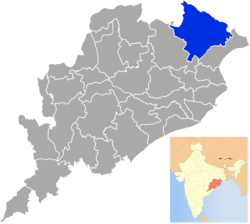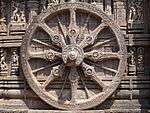Mayurbhanj district
Mayurbhanj district is one of the 30 districts in Odisha state in eastern India. Mayurbhanj district is the largest district of Odisha by area.[1] Baripada city is its headquarter. Other major towns are Rairangpur, Karanjia and Udala. As of 2011, it is the third-most-populous district of Odisha (out of 30), after Ganjam and Cuttack.
Mayurbhanj district ମୟୂରଭଞ୍ଜ | |
|---|---|
 | |
 Location in Odisha, India | |
| Coordinates: 21.933°N 86.733°E | |
| Country | |
| State | Odisha |
| Headquarters | Baripada |
| Government | |
| • Collector & District Magistrate | Shri Vineet Bhardwaj, IAS |
| • Divisional Forest Officer Cum Wildlife Warden | Shri Swayam Mallick, IFS |
| • Superintendent of Police | Shri Smit P. Parmar, IPS |
| Area | |
| • Total | 10,418 km2 (4,022 sq mi) |
| Elevation | 559.31 m (1,835.01 ft) |
| Population | |
| • Total | 2,519,738 |
| • Density | 240/km2 (630/sq mi) |
| Languages | |
| • Official | Odia, English, |
| • Other local language | Santhali, Ho |
| Time zone | UTC+5:30 (IST) |
| PIN | 757 xxx |
| Vehicle registration | OD-11 |
| Sex ratio | 1,005 ♂/♀ |
| Literacy | 65.98% |
| Lok Sabha constituency | Mayurbhanj |
| Vidhan Sabha constituency | 9
|
| Precipitation | 1,648.2 millimetres (64.89 in) |
| Website | www |
| This article is part of a series on |
| Odisha |
|---|
 |
| Governance |
|
| Topics |
| GI Products |
|
|
Districts Divisions |
|
|
Mayurbhanj is land-locked with a geographical area of 10,418 km2 (4,022 sq mi) and is in the northern boundary of the state. It is bounded in the northeast by Jhargram district of West Bengal, West Singhbhum and East Singhbhum districts of Jharkhand in the northwest, Balasore district in the southeast and by Kendujhar in the southwest.[1]
Demographics
According to the 2011 census Mayurbhanj district has a population of 2,519,738, roughly equal to the nation of Kuwait[2] or the US state of Nevada.[3] This gives it a ranking of 171st in India (out of a total of 640). The district has a population density of 241 inhabitants per square kilometre (620/sq mi). Its population growth rate over the decade 2001-2011 was 13.06%. Mayurbhanj has a sex ratio of 1006 females for every 1000 males and a literacy rate of 63.98%. 58.7% of the population is from Scheduled Tribes.
At the time of the 2011 Census of India, 54.33% of the population in the district spoke Odia, 24.81% Santali, 7.58% Ho, 4.07% Hindi, 3.45% Mundari, 1.34% Bengali, 0.47% Munda and 0.46% Urdu as their first language.[4]
In 2006 the Ministry of Panchayati Raj named Mayurbhanj one of the country's 250 most backward districts (out of a total of 640).[5] It is one of the 19 districts in Odisha currently receiving funds from the Backward Regions Grant Fund Programme (BRGF).[5]
Mayurbhanj district is known for various tribal community, they are Santals, Hos, Bhumij/Munda, Bhuinya, Mankadia, Kharia and others. Many tribal groups have their own script of writing such as, one of the tribal group Santali which got official status in 2003 by the 92nd amendment bill.[6] Other tribes which have their own script of writing include Bhumijj tribal community which speak Bhumij language and is written in Ol Onol script.[7][8]
| Year | Pop. | ±% p.a. |
|---|---|---|
| 1901 | 610,383 | — |
| 1911 | 729,218 | +1.79% |
| 1921 | 754,314 | +0.34% |
| 1931 | 889,603 | +1.66% |
| 1941 | 984,741 | +1.02% |
| 1951 | 1,028,825 | +0.44% |
| 1961 | 1,204,043 | +1.59% |
| 1971 | 1,434,200 | +1.76% |
| 1981 | 1,581,873 | +0.98% |
| 1991 | 1,884,580 | +1.77% |
| 2001 | 2,223,456 | +1.67% |
| 2011 | 2,519,738 | +1.26% |
| source:[9] | ||
Major Tribes
The district is an autonomous district. The main tribes of this district are Santal, Ho, Bhumij/Munda, Bhuinya, Mankadia and Kharia and others. Among these tribes, Santal and Ho are dominant in the district due to their active political participation.
Culture
The district has many tribal cultures like Santali culture, Ho dance and Mage Porob,Baa Porob,Hermuut,Heroh Porob,Karam,Jomnama and Jomsuim of Ho tribe and bhumij cultures. Some of the famous musicians and singers of the Ho,like Mangal Bandra, Pute Kerai, Punjabi Sirka, Dubung Sirka, Budhuram Samad, Ghanshyam Angrai, Subhlaxmi Bodra and the Santali, like Basen Murmu, come from this district. According to 2011 Census 83.86% people are Hindus, 1.34% are Muslims, 0.60% are Christians, 0.03% are Sikhs and Adivasis. Adivasism and Hinduism being the most followed religion there are many deshauli,jayra,temples found in the district some of which have ancient connections.
Vidhan sabha constituencies
The following is the nine Vidhan sabha constituencies[10][11] of Mayurbhanj district.
| No. | Constituency | Reservation | Extent of the Assembly Constituency (Blocks) |
|---|---|---|---|
| 26 | Jashipur | ST | Jashipur, Raruan, Sukruli, Kusumi (part) |
| 27 | Saraskana | ST | Saraskana, Bijatala, Bisoi, Kusumi (part) |
| 28 | Rairangpur | ST | Rairangpur (M), Rairangpur, Tiring, Bahalda, Jamda |
| 29 | Bangriposi | ST | Bangriposi, Kuliana, Shamakhunta |
| 30 | Karanjia | ST | Karanjia (NAC), Karanjia, Thakurmunda, Kaptipada (part) |
| 31 | Udala | ST | Udala (NAC), Udala, Gopabandhunagar, Kaptipada (part) |
| 32 | Badasahi | SC | Betnoti, Badasahi (part) |
| 33 | Baripada | ST | Baripada (M), Baripada, Khunta, Badasahi (part) |
| 34 | Morada | None | Morada, Suliapada, Rasgobindapur |
Notable places in Mayurbhanj District
Khiching' is an ancient village Under Sukruli Block.Sukruli Is The One Of famous Place In Mayurbhanj District of Odisha, India. It is the location of the Kichakeshwari Temple made from black stone.
Khiching is located about 50 km east of Keonjhargarh city 24 km west of Karanjia.There are several villages in the vicinity, including Sukruli, Kesana, Naupana, Kakharupana, Salabana, Viratagada, Kichakagada. Another nearby village is Singda. The major festival in Khiching is Sivarathri, which is celebrated over seven days. The major tourist attraction of Khiching is the Temple Of Maa Kichakeswari. The temple was constructed during the year 920/925. Goddess Kichakeshwari, which was not only ishtadevata and kuladevi of Bhanj dynasty but also the State deity of Princely State of Mayurbhanj ruled by them. The temple suffered in the hand of Vandals. King of Mayurbhanj, Maharaja Pratap Chandra Bhanjdeo reconstructed the temple in the year 1934 spending an approximate amount of ₹ 85,000.00. Height of the temple is 100 ft (30 m) and total area is 1764sq.ft. Main temple remains closed between 12 noon to 3 PM. There is a museum constructed by Maharaja Purna Chandra Bhanjdeo in the year 1922.
The Belgadia Palace is an 18th-century Victorian-era styled hill-top palace located in Baripada Mayurbhanj district, Odisha, India. This Palace is belongs to Bhanja Royal Family. Now this is open for common people but previously no one can allowed to enter Belgadia Palace without permission.
- Maa Kichakeswari Temple,Bahalda
The Maa Kichakeswari Temple,Bahalda is one of the famous temple in Mayurbhanj.
References
- "About District | Mayurbhanj District, Government of Odisha | India". Retrieved 10 June 2020.
- US Directorate of Intelligence. "Country Comparison:Population". Retrieved 1 October 2011.
Kuwait 2,595,62
- "2010 Resident Population Data". U. S. Census Bureau. Archived from the original on 19 October 2013. Retrieved 30 September 2011.
Nevada 2,700,551
- 2011 Census of India, Population By Mother Tongue
- Ministry of Panchayati Raj (8 September 2009). "A Note on the Backward Regions Grant Fund Programme" (PDF). National Institute of Rural Development. Archived from the original (PDF) on 5 April 2012. Retrieved 27 September 2011.
- https://m.telegraphindia.com/states/jharkhand/joy-greets-language-victory/cid/781935
- Tribals demand official status for Bhumij language
- "Demography | Mayurbhanj District, Government of Odisha | India". Retrieved 10 June 2020.
- Decadal Variation In Population Since 1901
- Assembly Constituencies and their EXtent
- Seats of Odisha
